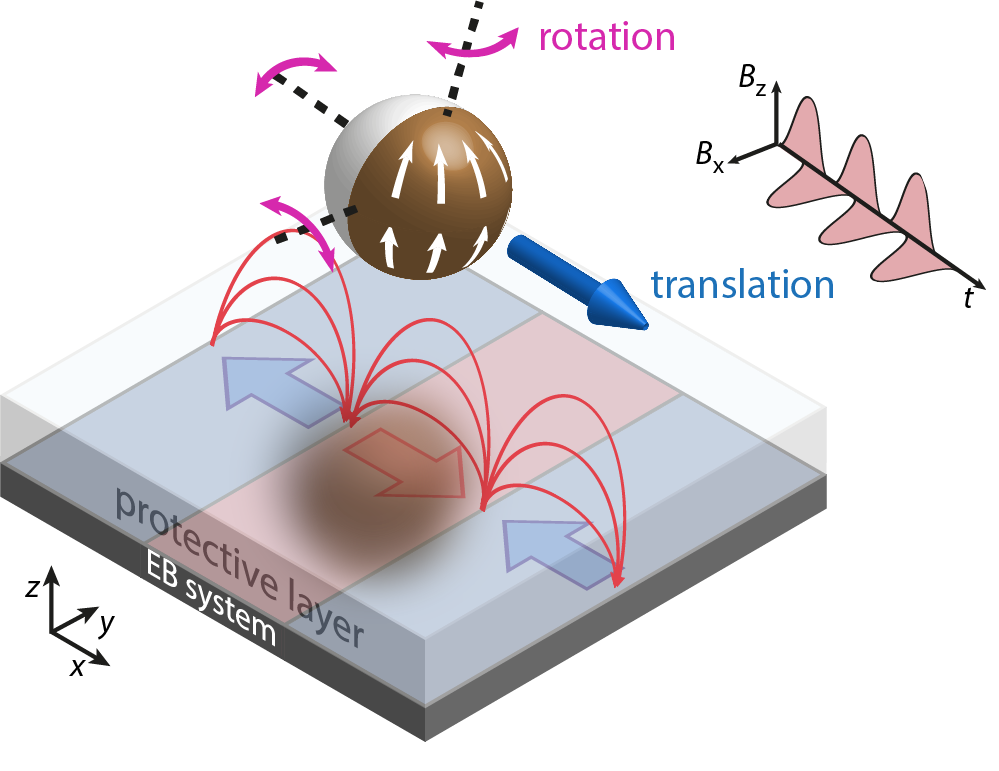This page contains automatically translated content.
Magnetic Janus particles improve biomolecule transport in miniature labs
 Image: Dennis Holzinger.
Image: Dennis Holzinger.In lab-on-a-chip systems, complex chemical processes take place in a very small space. Analogous to large apparatus in laboratories, channels, pumps, valves and measuring chambers the thickness of a human hair are located on plastic substrates the size of plastic cards. A sample, e.g. a drop of blood, passes sensors that analyze the chemical components of the sample. The sensors in turn translate these into electrical signals for analysis. Such systems are already used for diagnostics, for example in blood glucose meters or pregnancy tests. However, the technology still offers a great deal of development potential.
For about ten years, the Department of Functional Thin Films and Physics with Synchrotron Radiation at the University of Kassel (Prof. Dr. Arno Ehresmann) has been researching technologies that can transport specific biomolecules (e.g. analytes to be detected) in lab-on-a-chip systems through the reaction and analysis chambers in a targeted manner using magnetic micro- and nanoparticles. They have now developed a method that significantly improves control over these movements and accelerates transport. They have now published their results in the journal Scientific Reports.
The experimentalists have produced so-called Janus particles, which have two sides with different physical properties: Silica spheres three micrometers in diameter with a magnetic metal cap half covering the sphere. "For example, molecules from the sample to be analyzed bind to one side of the sphere, and the magnetic metal cap on the other side is used to control movement by external magnetic fields," explains first author Rico Huhnstock.
The second component is a magnetic thin-film substrate that has been microstructured into differently magnetized strip segments to generate the microscale magnetic fields needed to move the particles. By now applying external magnetic fields and periodically changing their directions, the researchers move the Janus magnetic particles aligned with them across the substrate in an aqueous solution. The arrangement also offers the possibility of spatially rotating the particles in a targeted manner. "The rotational motion of the spheres significantly increases the probability of adhesion of the analytes to the particles. This is a great advantage especially when the analytes are present in only very low concentrations. At the same time, we can in turn align the particles more precisely by rotating them over specific analysis chambers," Huhnstock describes. In this way, the molecules under investigation can be detected much more sensitively.
In addition, this method requires less power than previous systems and enables a faster throughput rate of the samples. The Janus particles move at up to 200 micrometers per second, about ten times faster than in current systems. This was the result of the evaluation of the particle movement by computer scientists from the Department of Intelligent Embedded Systems (Prof. Dr. Bernhard Sick) at the University of Kassel. "With our results from basic research, rapid detection with lab-on-a-chip technologies can be realized in the long term, which can detect biomolecules in a cost-saving way, for example as evidence of certain diseases, without having to rely on technology and personnel in a laboratory," Huhnstock said.
Scientific publication:
Huhnstock, R., Reginka, M., Tomita, A. et al. Translatory and rotatory motion of exchange-bias capped Janus particles controlled by dynamic magnetic field landscapes. Sci Rep 11, 21794 (2021). https://doi.org/10.1038/s41598-021-01351-x
Contact:
Prof. Arno Ehresmann
Experimental Physics IV
Phone: 0561 804-4060
Email: ehresmann[at]physik.uni-kassel[dot]de
Rico Huhnstock
Experimental Physics IV
Phone: 0561 804-4015
E-mail: rico.huhnstock[at]physik.uni-kassel[dot]de
Press contact:
Sebastian Mense
University of Kassel
Communications, Press and Public Relations
Phone: 0561 804-1961
E-mail: presse[at]uni-kassel[dot]de
& nbsp;